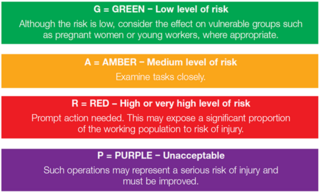RAPP Assessment: Improve manual handling with the STILL RAPP tool

Manual handling injuries are part of a wider group of musculoskeletal disorders (MSDs). The term ‘musculoskeletal disorders’ covers any injury, damage or disorder of the joints or other tissues in the upper/lower limbs or the back.
Some MSDs are caused by work activities but some are caused by activities outside work or may be the result of illnesses or diseases unrelated to work. How much a person is affected by MSDs varies widely. Some people are able to continue normal activities but more severely affected people may need adjustments to their workplace to help them continue to work or may need to take time off work to recover.
Many episodes of MSD pain get better quite quickly. Look at HSE’s web page ‘Musculoskeletal disorders’ for more information. The Labour Force Survey (LFS) estimates that work-related MSDs, including those caused by manual handling, account for around 40% of all work-related ill health. Find more information on HSE’s web page ‘Work-related MSD statistics’ or download here:
- Work related musculoskeletal disorder statistics (WRMSDs) in Great Britain, 2019 PDF, 470 KB Download
There is evidence that, as well as manual handling, heavy manual labour, awkward postures and a recent or existing injury are all risk factors in the development of work-related MSDs. There are things you can do to prevent or minimise MSDs, however you cannot prevent them all. To help reduce the risk of manual handling injuries in your workplace:
- comply with the Regulations and guidance;
- review risk assessments when necessary;
- encourage early reporting of symptoms;
- ensure any cases of manual handling injury are managed effectively;
- consult and involve the workforce and their representatives.
What do the Manual Handling Operations Regulations require?
The Regulations require employers to:
- avoid the need for hazardous manual handling, ‘so far as is reasonably practicable’;
- assess the risk of injury from any hazardous manual handling that can’t be avoided;
- reduce the risk of injury from hazardous manual handling, ‘so far as is reasonably practicable’.
Pushing and pulling
In pushing and pulling operations the load might be slid, rolled or moved on wheels. Observe the general posture being used while the pushing or pulling operation is being carried out. The task is likely to be low risk if:
- the force is applied with the hands; and
- the torso is largely upright and not twisted; and
- the hands are between hip and shoulder level; and
- the distance involved is no more than about 20 m.
Mechanical assistance and goods handling
Technique - Mechanical assistance involves the use of handling aids – some manual handling is retained but bodily forces are applied more efficiently, reducing the risk of injury. There are many examples:
- A simple lever can reduce the risk of injury by decreasing the bodily force required to move a load, or by removing fingers from a potentially damaging trap.
- A hoist, either powered or hand-operated, can support the weight of a load and leave the handler free to control its position.
- A trolley, sack truck or roller conveyor can greatly reduce the effort required to move a load horizontally.
- Chutes and flow racking are convenient ways of using gravity to move loads from one place to another.
- Handling devices such as hand-held hooks or suction pads can simplify the problem of handling a load that is difficult to grasp.
- Hand pallet trucks and roll cages are ways of moving bulky loads manually.
- Turntables, inverters and drum rotators can be used to manipulate bulky loads.
- Powered lift trucks can be used to move items such as pallets into position for manual handling of individual items on the pallet.
Key Facts from the HSE Summary Statistics for Great Britain 2019 (Below)
- 1.4 million working people suffering from a work-related illness, of which, musculoskeletal disorders attributed to 37% of all working days lost in 2018/ 2019
- 81% of work related musculoskeletal disorders were related to upper limb, neck or back injuries.
- A total of 498,000 workers are suffering from work related musculoskeletal disorders.
- 6.9 million working days were lost due to work related musculoskeletal disorders in 2018/ 2019
Introducing the STILL RAPP Tool
There are two types of pushing and pulling operations you can assess using the HSE designed RAPP Tool:
- moving loads on wheeled equipment, such as hand trolleys, pump trucks, carts or wheelbarrows.
- moving loads without wheels, which might involve actions such as dragging/ sliding, churning (pivoting and rolling) and rolling.
This assessment focuses on moving loads on wheeled equipment, such as hand trolleys, pump trucks, carts or wheelbarrows and should be used to assist customers with their Manual Handling Risks carrying out this operation.
For Moving loads without wheels, the customer can follow the guidance and RAPP tool provided by the HSE.
Use of the tool may not comprise a full risk assessment
Please view the ‘Resources’ area below and you will find guidance on how to complete an assessment!

How to complete an assessment
Please view the ‘Resources’ area below and you will find guidance on how to complete an assessment!
Comments
No comments
Subscribe to our blog!
As soon as a new article is published, we will notify you! You can unsubscribe at anytime.

Leave a comment